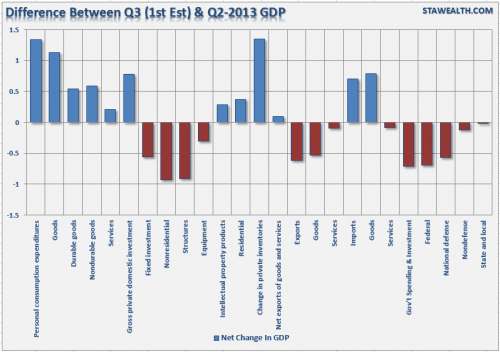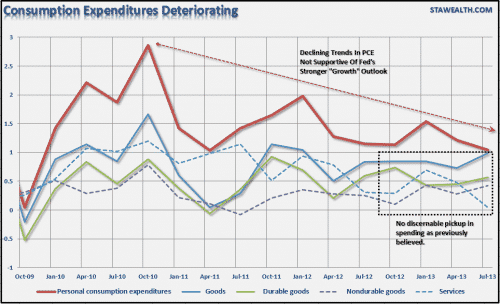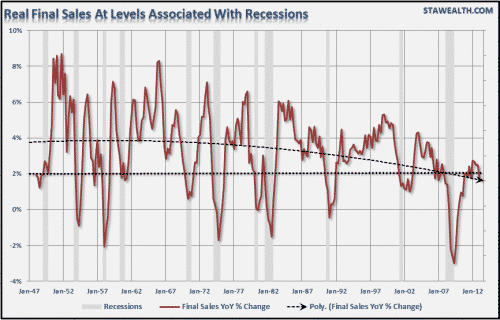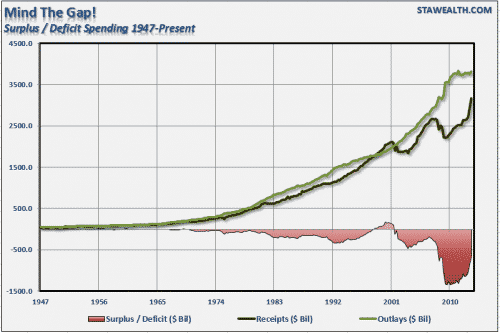Q3 GDP – An Inventory Restocking Story
The release of the first estimate of Q3 GDP was initially met with excitement as the headline print of 2.82% growth was far in excess of consensus estimates of 2.0%. Unfortunately, the euphoria quickly faded as the details painted a much more dismal story and one that I correctly pointed out on September 17th when I stated:
“It has been a ‘Summer of Recovery’ for the U.S. economy with GDP growth rising from 1.1% in the first quarter to 2.5% in the second and manufacturing surveys showed sharp jumps in new orders and outlooks. The same occurred in the Eurozone with Markit’s PMI reports showing sharp bounces higher and hopes that the recession that has plagued the region was finally coming to an end. The question of sustainability remains.
I have noted several times as of late, most recently here, that the recent bumps in economic activity, particularly in the survey and sentiment data, is most likely due to short term restocking activity rather than actual economic improvement. The same goes for the recent improvements in the Eurozone data. This, of course, has been the same recovery/slowdown cycle that the economy has been trapped in ever since the end of the financial crisis as shown in the below.
With each recovery has come the hope that the economy was finally set to accelerate higher; but that has yet to be the case. This has kept the Federal Reserve engaged in ongoing monetary interventions to artificially suppress interest rates, and boost asset prices, in order to pull forward future consumption to support the current economy. The problem becomes the “void” when the future arrives which requires more rounds of support.”
That “restocking cycle” was clearly evident in the GDP report. The chart below shows the raw change from Q2 to Q3 of the components of the GDP report. Notice the large change in private inventories.
The surge in inventories was expected due to sluggish Q4 growth in 2012 and Q1 of 2013 which led to an inventory drawdown as business remained on the defensive. The last few months have seen a surge in orders and activity for manufacturers as orders were placed to restock. This bounce in activity has led to hopes that the activity will be sustained going into the end of the year, but the weakness in the underlying consumer trends brings this into question.
The most recent GDP report clearly shows that the demand side of the economic equation is not only slowing domestically but internationally as both exports and imports decelerated.
Furthermore, as shown in the next chart, consumer spending has continued to weaken since its peak in 2010. The last couple of quarters has shown a noticeable decline is services related spending as budgets tighten due to lack of income growth as disposable personal incomes declined in the latest report. The slowdown in dividends, wages and salaries were partially offset by a rise in social welfare and government benefits. Unfortunately, rising incomes derived from government benefits does not lead to stronger economic growth.
The chart of real final sales below shows the underlying problem. Real final sales in the economy peaked in early 2012 and has since been on the decline despite the ongoing interventions of the Federal Reserve. The lack of transmission into the real economy is clearly evident.
The current level of real final sales at 1.62% is the third straight quarter of below 2% growth. Historically, three quarters of below 2% growth in real final sales has been more consistent with economic recessions.
Today’s report confirms my ongoing view that the private sector remains weak and has likely weakened further in recent months. The problem is that the “wiggle room” for the economy to absorb an exogenous shock is now razor thin. As I have discussed recently, the weakness in consumer spending and incomes bodes poorly for the upcoming holiday season.
A Word About The Budget Deficit
Lately, there have been numerous articles discussing the rapid decline in the budget deficit. Economists and analysts have been quick to assume that the increase in revenues, as government expenditures slowed, was a sign of a strengthening economy. The chart below shows the budget surplus/deficit from 1947 to present. Notice that real budget deficits did not occur until post 1980 as debt became the offset for weakening economic prosperity.
The reality is that the surge in tax revenues was a direct result of the “fiscal cliff” at the end of 2012 as companies rushed to pay out special dividends and bonuses ahead of what was perceived to a fiscal disaster. The large surge in incomes was primarily generated at the upper end of the income brackets where individuals were impacted by higher tax rates. Those taxes were then paid in April and October of 2013 and accounted for the bulk of the surge in tax revenue to date. Also, it is important to remember that payroll taxes also increased due to the expiration of the payroll tax cut from 2010.
However, the recent Q3 GDP report, and Q4, will highlight the end of income tax revenue surge as disposable income growth decelerates. This deceleration in disposable income will likely be exacerbated by sharply rising costs from the onset of the Affordable Care Act. However, the ACA is a double edged sword that leads to massive increases in government spending to support a fundamentally flawed healthcare model. It is currently estimated that by 2020 the existing government entitlement programs will consume roughly 75% of all tax revenue. The addition of another underfunded entitlement program will likely absorb the remaining share leaving only debt to fund the remaining spending needs into the future.




Comments are closed.